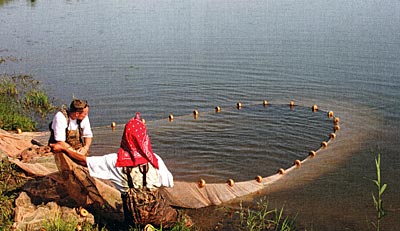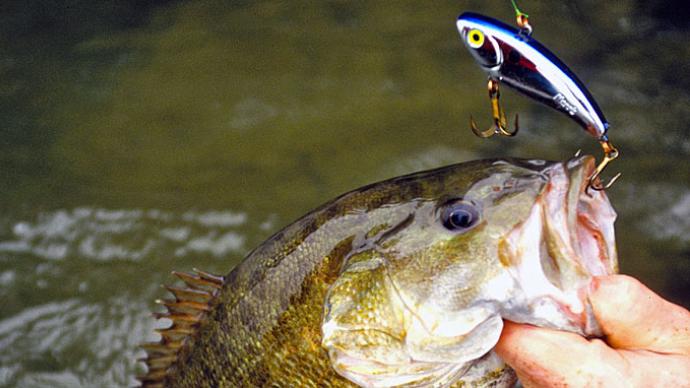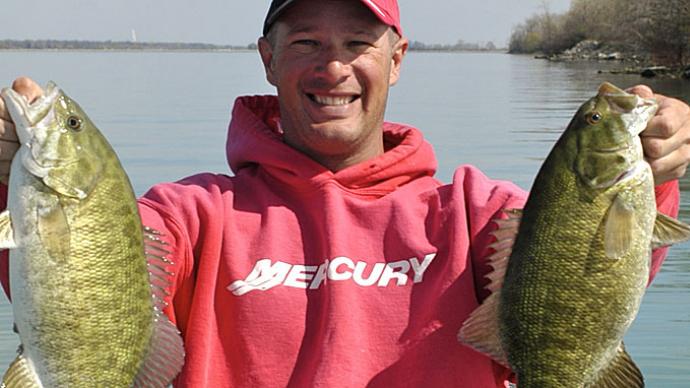
Pound for pound, inch for inch, smallmouth bass are pure energy and fun on the business end of light tackle.
But will they work in your northern pond? Can you have a good smallmouth fishery in small waters?
The answer is, yes—if you work at it.
Smallmouth bass are more dependent on great habitat than most other fish species. Largemouth bass adjust, bluegills survive, and redear sunfish and walleye disappear, if they don't have their best habitat
Focus on smallmouth bass habitat, first. Smallies love rocky outcroppings, gravel, and wood. Picture this: a ridge of softball to basketball-sized rocks, stacked parallel to shore, in water eight feet deep, and four feet tall. Inside this ridge, two big tree trunks with five of the biggest limbs still attached, all small limbs and twigs gone, lying perpendicular to shore at a 45-degree angle across your rock ridge, headed to deep water from near shore. Beside the base of the tree, in 2-3 feet of water, is a gravel bed, about the size of the hood of a car. Replicate that around the pond.
That's smallmouth bass habitat.
But wait, there's more. What do smallmouth bass eat? Their favorite is a favorite of all predator fish, crawfish. Smallies are predator fish and have to make a living off other living creatures. They absolutely love crawfish, small game fish, and sunfish. Minnows are a staple as well. Be sure to understand your forage fish species, their lifestyles, and habitat. What kind of crawfish are native to your area? How do they feed and reproduce?
Your job is to figure out the best forage species for your smallmouth bass and cultivate them in a fashion that provides more food than competition.
That little word, competition, is a big stumbling block to growing healthy populations of smallmouth bass in northern ponds.
That's also part of the concept meant in the third line of this story, "yes—if you work at it." Two obstacles are seemingly always present in smallmouth bass ponds: growing enough of the right size food, and reproduction of your smallies adequately to recruit and support the population. It seems smallies either reproduce way too much in northern waters or not nearly enough. Part of your job is to regularly monitor both the food chain and the recruitment of young bass into the system.

Of those two concepts, the food chain is the most important. If smallmouth don't reproduce enough, you can buy some fish to ensure age classes coming up the chain. But if the food chain isn't working, don't expect to get the best growth rates and reasonable sizes for a fun fishery. Keep in mind, smallmouth bass have a big mouth, but not big enough to keep up with several key forage species. Bluegill, by far, are the hardest forage fish to manage in a smallmouth bass pond. In northern waters, bluegill reproduce once, maybe twice yearly, and quickly outgrow smallies' mouth gape size. At that point, bluegill become the dominant species, competing in the food chain and serving no purpose for your bass. Don't count on bluegills as an important forage fish for smallmouth bass ponds. Pumpkinseeds are much better. They don't overwhelm their environment with big numbers, and their growth rates are more in line with the needs of smallmouth bass.
Yellow perch can also be a key forage fish player in smallmouth bass ponds, especially if you can harvest some of them once their numbers and sizes begin to rise.
Fathead minnows are a great choice if they can keep the pace with other species you choose. Part of your strategy may mean fathead minnows for the first few years, and when they disappear, you've stocked other species to fill a different niche as your smallmouth are growing.
As you think about how to manage smallies in smaller waters, think about this. You already know the best habitat. Provide great habitat over 20-30% of the pond. Plan to move the water. Smallies love moving water. Think about using circulators to create a gentle current.
Part of your strategy should also be designing a way to harvest fish and do it efficiently. Shape your pond where you can use a seine, trap net, or lift net to capture a bunch offish at a time to selectively harvest once or twice per year.
If you design a cove with no obstructions, where a fifty-foot seine can be pulled, you can effectively sample and harvest fish at the same time once or twice per year. Plus, a seine of that size can prove recruitment (or lack of) in just a few minutes each fall, before the water gets too cold. Pull that seine, trap and collect fish. Look them over and if that size fish or that species isn't offering support for your smallmouth bass, then take them out.
Here's the bottom line. Yes, you can have a nice smallmouth bass fishery in small northern waters. Provide the very best habitat not only for the smallies, but for the best forage choices in your region of the country. Expect to make yearly adjustments, maybe twice a year depending on your pond. Think beyond the obvious, make a plan, and include ways to capture lots offish in a short period. Monitor the reproduction of all your species of choice and make sure they are staying inbounds to enhance smallmouth growth.
If you do these things and enjoy monitoring what's going on under your water, you can have a fun smallmouth bass fishery in small northern waters.
Reprinted with permission from Pond Boss Magazine



